Music is the universal language
“Glory to God in the highest heaven, and on earth peace to those on whom his favor rests.” - Luke 2:14
General Interest
Jackson Brings Iconic Rhoads to American Series Lineup

Today, Jackson introduces a legendary shape to its prestigious American Series lineup: The American Series Rhoads RR24 and RR24 HT. Born from a 1980 collaboration between metal icon, Randy Rhoads, and founder, Grover Jackson, this distinctive angular shaped design was built for the ultimate shredding performance. Featuring USA-made Seymour Duncan® JB and ‘59 humbuckers pickups, a reverse 6 in-line headstock and the signature offset Rhoads alder body, the American Series Rhoads delivers the bold, brutal tone that metal enthusiasts demand.
Meticulously crafted in Jackson’s Corona, California factory, the American Series Rhoads is built to devastating perfection through premium materials and components including alder bodies with three-piece neck through construction and 12-16" compound radius ebony fingerboard with jumbo stainless steel frets. This launch expands the American Series beyond its current Soloist™ and Virtuoso™ models, reinforcing Jackson's commitment to supporting heavy music artists with uncompromising quality instruments. Rhoads' pursuit of precise, architectural solos helped define the template for metal guitar playing that continues to influence generations of players. Embodying the authentic Rhoads DNA, this American-made guitar is engineered for shredding perfection.

“The American Series Rhoads was created to bring the legendary shape that metal guitarists have coveted for decades to a new generation,” said Jon Romanowski, VP of Product, Jackson. “Built in the U.S., this premium guitar is engineered for players who demand uncompromising metal tone and performance.”
The American Series Rhoads is available in two models: the RR24 and RR24 HT, with the bridge being the main difference between them. The RR24 HT features a Hipshot hardtail bridge made for rock-solid tuning stability and ease of use for string changes or for drop tunings on the fly. This guitar is available in Satin Black and Snow White. The RR24 takes a different approach with its recessed 1500 Series Floyd Rose® double-locking tremolo system for dive bombs, squeals and flutters while staying in tune through brutal playing. This tremolo-equipped model is available in Satin Black, Matte Army Drab and Snow White.
To introduce the legendary American Rhoads series, Jackson has partnered with metal virtuosos and signature artists, Brandon Ellis and Jeff Loomis. Both Ellis and Loomis continue to leave an indelible mark on the metal genre through their revolutionary playing styles and technical mastery. The Rhoads shape continues to empower guitarists to push the boundaries of heavy music, delivering crushing tone and uncompromising performance. This collaboration reinforces Jackson's commitment to supporting the artists who define modern metal while honoring the legacy of one of guitar's most influential innovators.
“This axe embodies everything the Jackson name has always stood for to me,” said Brandon Ellis. “It's built for metal and speed, and comes 100% tour-worthy right off of the shelf, with bulletproof American construction, high quality specs and hardware and contemporary upgrades. The easily accessible spokewheel adjusted truss rod, push-in style tremolo bar, stainless steel Floyd Rose upgrades, glow in the dark side dots and locking tuners are all huge quality of life improvements for performing musicians like myself. I have the matte finished olive drab version which both feels amazing in my hands and looks killer on anybody who wields this classic, sharp-angled, metal beast of a guitar!”
“The American Series Rhoads is an amazing metal masterpiece!” said Jeff Loomis. “Aggressive looks with killer playability all over the neck, this guitar really stands out. Partnering with Jackson again to showcase this guitar with Brandon Ellis was a total blast and unforgettable experience.”
Watch these legends unleash their metal prowess: Presenting the American Series Rhoads Feat. Jeff Loomis & Brandon Ellis | Jackson Guitars. High-resolution product and lifestyle images of the American Series Rhoads RR24 can be found HERE. Full product descriptions and specifications of the American Series Rhoads RR24 can be found HERE.
AMERICAN SERIES RHOADS RR24
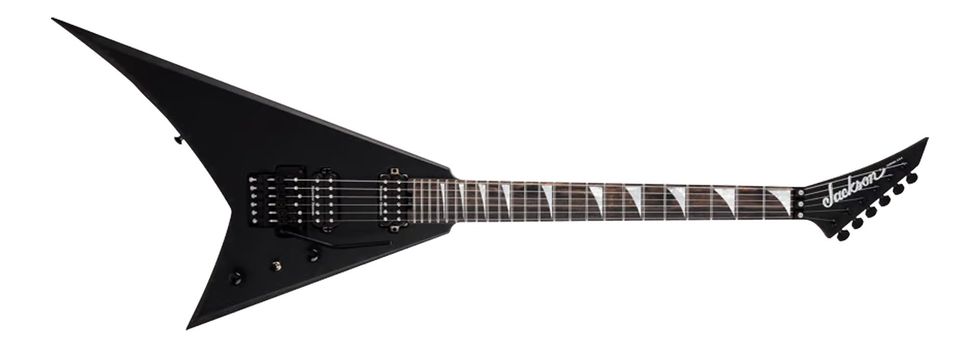
($2,849.99 – $2,899.99 USD, £2,249 GBP, €2,649 EUR, $5,149 – $5,249 AUD, ¥528,000 JPY)
The RR24’s offset Rhoads alder body turns heads with its sleek, weapon-like contours while providing resonant, lively tone. Its neck-through-body three-piece maple neck with graphite reinforcement delivers supreme stability and sustain. 24 Jumbo stainless-steel frets top the 12”-16” compound radius ebony fingerboard allowing effortless bending across the entire fretboard. For tone that’s tight yet expressive, we’ve equipped the RR24 with Seymour Duncan® JB and ‘59 humbuckers. These USA-made pickups roar with thick distortion when you dig in, cleaning up nicely for singing leads. The recessed 1500 Series Floyd Rose® double-locking tremolo system lets you execute dive bombs, squeals and flutters while staying in tune through heavy abuse.
AMERICAN SERIES RHOADS RR24 HT
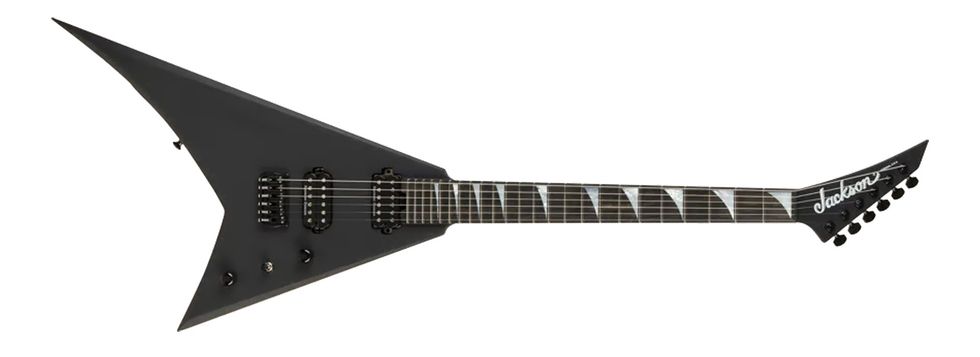
($2,729.99 – $2,779.99 USD, £2,199 GBP, €2,599 EUR, $4,949 – $5,049 AUD, ¥517,000 JPY).
The RR24’s offset Rhoads alder body turns heads with its sleek, weapon-like contours while providing resonant, lively tone. Its neck-through-body three-piece maple neck with graphite reinforcement delivers supreme stability and sustain. 24 Jumbo stainless-steel frets top the 12”-16” compound radius ebony fingerboard allowing effortless bending across the entire fretboard. For tone that’s tight yet expressive, we’ve equipped the RR24 HT with Seymour Duncan® JB and ‘59 humbuckers. These USA-made pickups roar with thick distortion when you dig in, cleaning up nicely for singing leads. The Hipshot® hardtail bridge makes for rock-solid tuning stability, and ease of use for string changes or for drop tunings “on the fly”.
“We said, ‘F**k England, let’s move to America’”: Peter Frampton reveals that he left the UK because Humble Pie hated having screaming girls at their gigs

Every band wants their music to be heard – but what if the attention gets a bit too intense? When Humble Pie’s 1969 single, Natural Born Bugie, peaked at number 4 in the UK charts, the rockers quickly grew tired of the screaming fans that began to attend their gigs.
In a new interview with Uncut, vocalist and lead guitarist Peter Frampton admits that he particularly hated the fangirls that Natural Born Bugie lured in. “It was a hit, so of course we had to play it on Top Of The Pops,” he recalls. “Steve Marriott [vocalist] really didn’t want to do it. He wasn’t thrilled. Of course, the first time we did it, as soon as we did our next gig we got screamed at.”
Prior to being in Humble Pie, Frampton and the late Marriott were keen to shake off a “popstar” image. Record labels weren’t treating them seriously, and Humble Pie was there way of gaining a bit of respect – however, when exposed to a mass of female fans on Top Of The Pops, the pair of singers were yet again treated like “pin-up” boys next door.
“I looked at Steve, Steve looked at me and we said, ‘They’re screaming?’” Frampton says. “That’s why we had formed Humble Pie, to get away from that! So that’s when we said, ‘Fuck England, let’s move to America.’”
But it wasn’t just the singers who noticed the screaming. Drummer and keyboardist Jerry Shirley chips in, adding: “We wanted to get away from the screamers. We even started our set with an acoustic section, so Peter was sat there with an acoustic guitar and all these girls were screaming at him. It was not normal.”
Frampton goes on to admit that Marriott hated the response so much that he wanted to cut Natural Born Bugie from the set entirely. “Steve didn’t want to play the single at concerts,” he explains. And, for a short while, the band would indeed leave the track out of their set.
However, Humble Pie have since learned to love the single once again. The track has even been remastered for a shiny re-release of the band’s 1969 debut, As Safe As Yesterday Is.
The remastering of As Safe As Yesterday is out now.
The post “We said, ‘F**k England, let’s move to America’”: Peter Frampton reveals that he left the UK because Humble Pie hated having screaming girls at their gigs appeared first on Guitar.com | All Things Guitar.
The iconic Rhoads is “returning home to California” as Jackson announces its addition to its American Series

Jackson’s iconic Rhoads blueprint – first conceived by both Ozzy Osbourne guitarist and legend Randy Rhoads and Jackson founder Grover Jackson – is “returning home to California”, as it makes its entry into the brand’s American Series lineup.
Two new models – the American Series Rhoads RR24 and RR24 HT – are built in Jackson’s Corona, California factory, which also produces Jackson’s most high-end instruments.
Delivering “uncompromising quality and performance”, the American Series Rhoads features USA-made Seymour Duncan JB and ‘59 humbuckers for a “tight yet expressive” tone, a reverse six-in-line headstock, resonant alder body with “weapon-like” contours, and a 12”-16” compound radius ebony fingerboard with 24 jumbo stainless steel frets.
Specs are, for the most part, identical on each model, except – for the keen-eyed amongst you paying attention to naming conventions, the RR24 HT sports a Hipshot hardtail bridge “for rock-solid tuning stability”, while the RR24 is equipped with a recessed 1500 Series Floyd Rose double-locking tremolo system – perfect for those huge divebombs.
 Credit: Jackson
Credit: Jackson
The addition of the RR24 and RR24 HT expands Jackson’s American Series beyond its existing Soloist and Virtuoso models.
“The American Series Rhoads was created to bring the legendary shape that metal guitarists have coveted for decades to a new generation,” says Jon Romanowski, VP of Product, Jackson.
“Built in the US, this premium guitar is engineered for players who demand uncompromising metal tone and performance.”
 Credit: Jackson
Credit: Jackson
The brand adds: “Rhoads’ pursuit of precise, architectural solos helped define the template for metal guitar playing that continues to influence generations of players. Embodying the authentic Rhoads DNA, this American-made guitar is engineered for shredding perfection.”
Granted the honour of being the first guitarists to take the new American Series Rhoads for a spin are metal virtuosos and Jackson artists Brandon Ellis and Jeff Loomis, formerly of the Black Dahlia Murder and Arch Enemy, respectively. Watch them tear it up in the video below:
“This axe embodies everything the Jackson name has always stood for to me,” says Brandon Ellis. “It’s built for metal and speed, and comes 100% tour-worthy right off of the shelf, with bulletproof American construction, high quality specs and hardware and contemporary upgrades.
“The easily accessible spokewheel adjusted truss rod, push-in style tremolo bar, stainless steel Floyd Rose upgrades, glow in the dark side dots and locking tuners are all huge quality of life improvements for performing musicians like myself.”
“The American Series Rhoads is an amazing metal masterpiece!” adds Jeff Loomis. “Aggressive looks with killer playability all over the neck, this guitar really stands out. Partnering with Jackson again to showcase this guitar with Brandon Ellis was a total blast and unforgettable experience.”
The RR24 is available in Satin Black, Matte Army Drab and Snow White, while the RR24 HT comes in Satin Black and Snow White.
The RR24 and RR24 HT are priced at £2,249 and £2,199, respectively.
For more info, head to Jackson.
The post The iconic Rhoads is “returning home to California” as Jackson announces its addition to its American Series appeared first on Guitar.com | All Things Guitar.
Deftones' Stephen Carpenter Rig Rundown
California metal giants Deftones returned this year with Private Music, their first album in five years. In support of it, they ripped across North America on a string of headline shows and support slots with System of a Down.
We linked with Deftones guitarist Steph Carpenter for a Rig Rundown back in 2013, but a lot has changed since then (and as Carpenter reveals in this new interview, he basically disowns that 2013 rig). Back in August, PG’s Chris Kies caught up with Carpenter again ahead of the band’s gig in Milwaukee, Wisconsin, where the guitarist gave us an all-access walkthrough of his current road rig.
Brought to you by D’Addario
Blue Battle-Axe
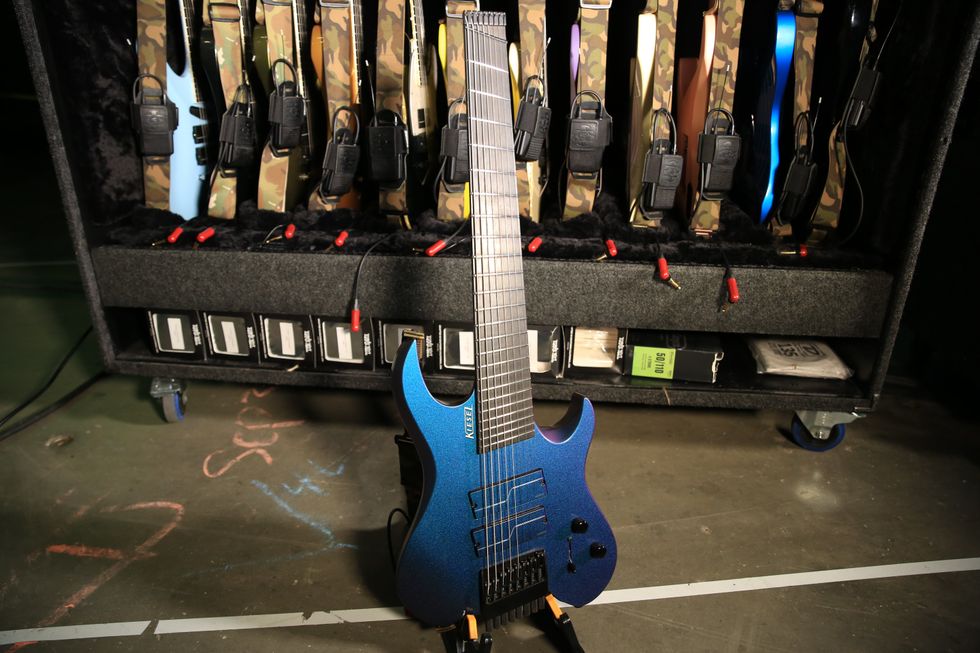
This headless, color-shifting Kiesel Vader 8 was the first Kiesel that Carpenter got his hands on.
Kiesel Kavalcade
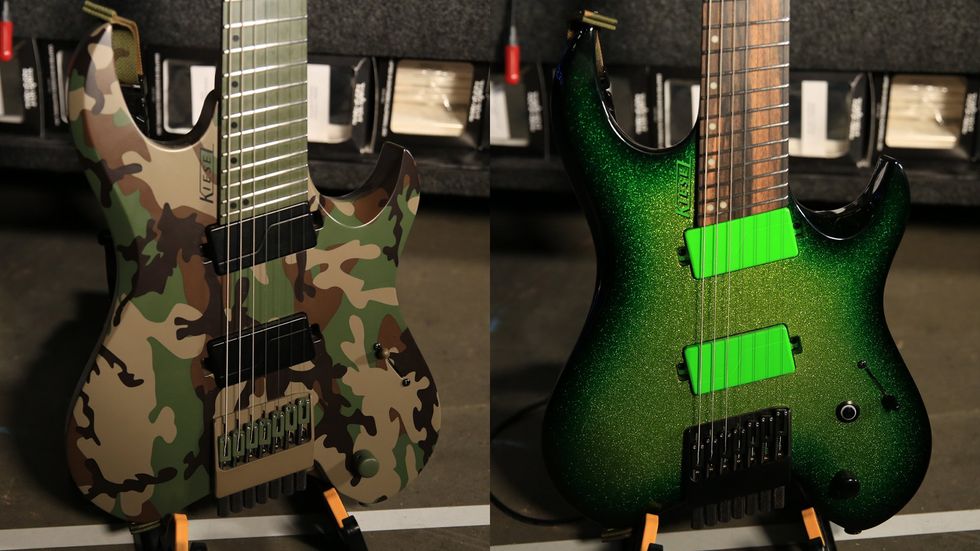
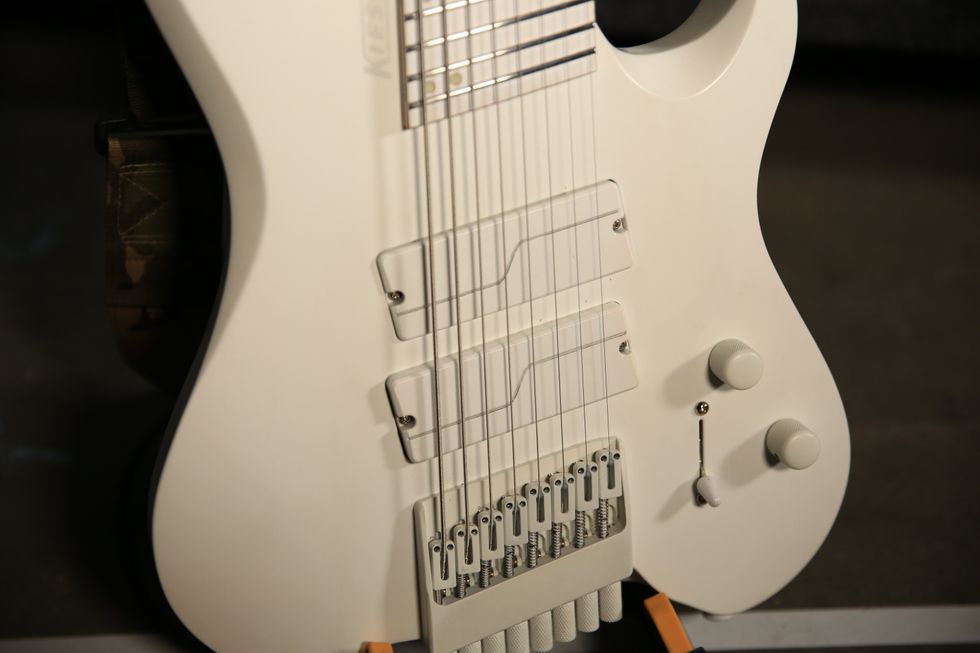
Carpenter requested Vader models in all-black, all-white, and goldtop finishes, then Jeff Kiesel himself surprised Carpenter with the remainder, including the camo and green sparkle models shown here. Carpenter will choose which guitar to use based on how he’s feeling each evening. To record Private Music, he switched between his trusty ESPs and these new favorites.
Steph’s Selections
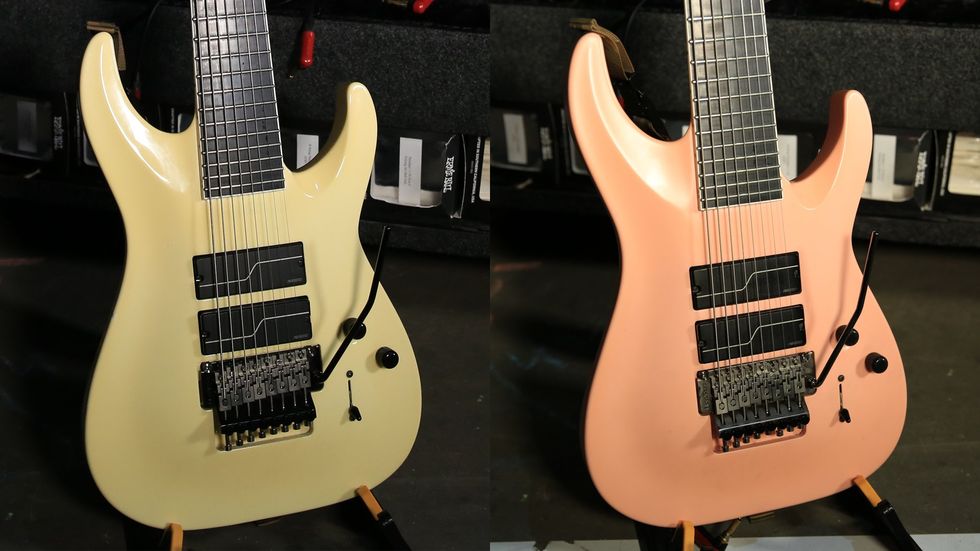
One of Carpenter’s two guitar vaults is full of his current favorite ESPs. Of those, this glow-in-the-dark version, along with the pink-finish model, is his top pick. Curious about his pickup configuration? It’s got nothing to do with sound; it’s purely based on how guitarists like Vivian Campbell and Adrian Vandenberg set up their guitars. Carpenter loved the look, so he copied it.
Back to Bogners
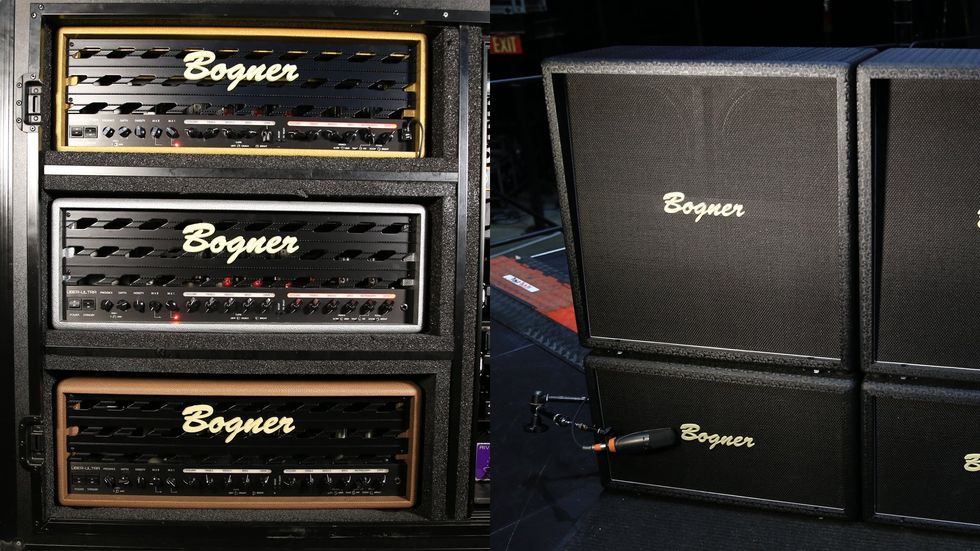
Carpenter says he’s had “too many fails” relying on a completely digital rig, so these days he rolls with a hybrid setup designed by his tech, Greg Dubinovskiy, and Dave Friedman, the latter of whom built the rig.
It’s based around these KT88-loaded Bogner Uberschall Uber-Ultra heads, which are wired to two Bogner 2x12 UberKabs (with one Celestion V-30 and one G12T-75 each) and two Bogner 4x12 UberKabs (with two V-30s and two G12T-75s in an X pattern). A Shure Nexus 57 and Shure KSM32 are used to capture the amp sound.
Rack Rundown
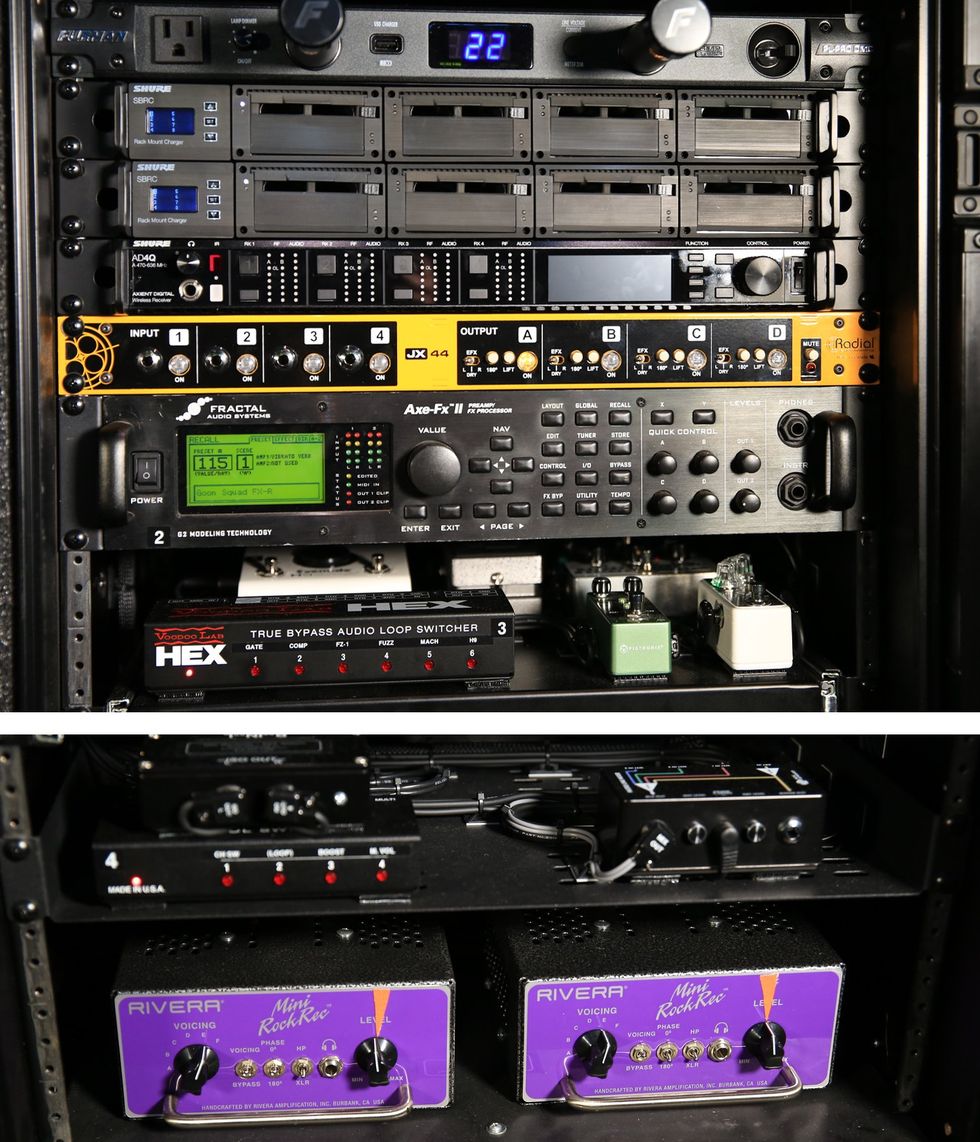
Beside the Bogner’s, another rack houses a Shure AD4Q, Radial JX 44, and a Fractal Axe-Fx II. (Carpenter has no desire to upgrade to the latest model.) Lower down, there’s a pair of Rivera Mini RockRecs.
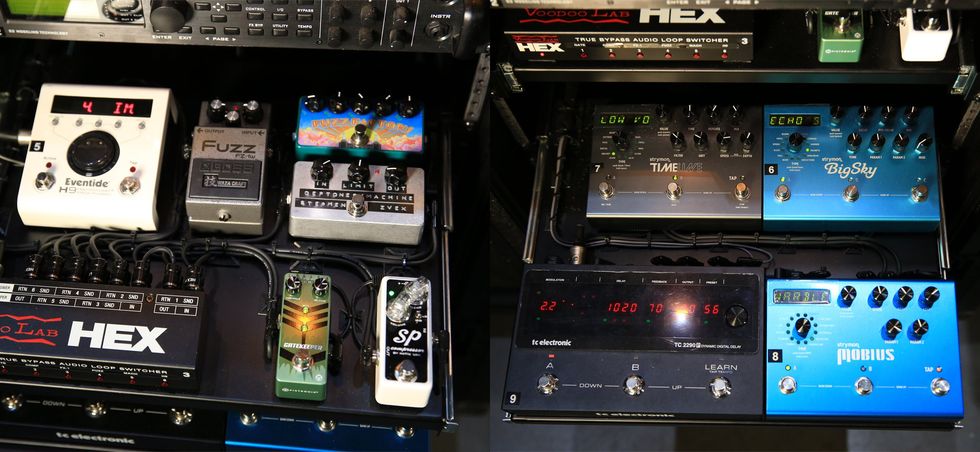
Most of Carpenter’s pedals are shelved below these units, including an Eventide H9, Boss FZ-1, ZVEX Fuzz Factory, custom ZVEX Machine, , Pigtronix Gatekeeper, Xotic SP Compressor, Strymon Mobius, Strymon BigSky, Strymon Timeline, and TC Electronic TC 2290. A Voodoo Lab Hex powers the pedal party.
Steph Carpenter’s Pedalboard
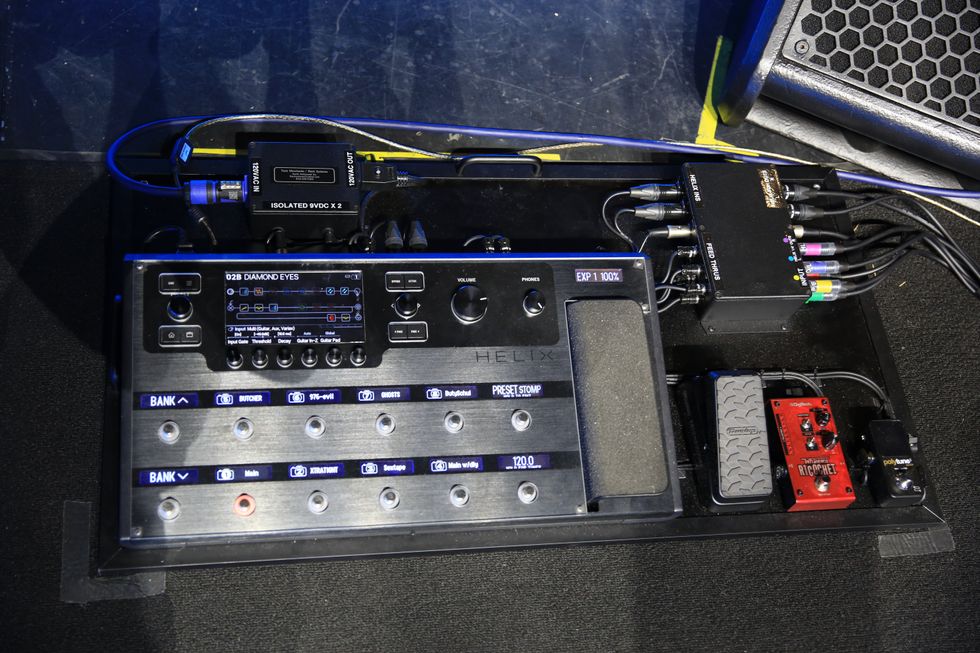
Carpenter’s Line 6 Helix unit is the brain of his setup, and handles all switching. Also on hand are a DigiTech Whammy Ricochet, a Dunlop Volume (X) Mini pedal, and a TC Electronic PolyTune 3 Noir.
“He took the living influence of Bob Dylan, and he turned that into a dragon in his hands”: Vernon Reid on why Jimi Hendrix is unsurpassed as a guitar hero
![[L-R] Jimi Hendrix and Bob Dylan](https://guitar.com/wp-content/uploads/2025/09/Jimi-Hendrix-Bob-Dylan@2000x1500.jpg)
Living Colour’s Vernon Reid has revealed his ultimate guitar hero – and, unsurprisingly, it’s Jimi Hendrix.
In a new interview with Classic Rock, Reid asserts that nobody can surpass the genius of Hendrix. “There are many other heroic guitarists before him, but he went against all the odds and expectations,” he explains. “He took the living influence of Bob Dylan, and he turned that into a dragon in his hands.”
- READ MORE: “Did you guys make a mistake?”: MGK admits he’s baffled as to why Bob Dylan is a fan of his
Reid picks out Hendrix’s red-hot performance in 1967 at Monterey Festival as his case in point. The show saw him dousing a 1965 Fender Stratocaster in lighter fuel, with the blaze leading to Hendrix burning both his hands and being sent to hospital following the performance.
“When he burnt his guitar at Monterey, it was a crypto critique of capitalism,” Reid reflects. “What a guitar meant for everyone, he changed it. And he did it with incredible songs.”
It’s not the first time Reid has voiced his respect for Hendrix. Last November, Reid picked out Manic Depression from Hendrix and The Experience’s 1967 debut, Are You Experienced, as one example of Hendrix’s “incredible” catalogue.
“Manic Depression doesn’t get nearly enough respect for what a groundbreaking song it STILL is,” he wrote on X. “It describes struggles with mental illness directly, not via metaphor. It was unprecedented in rock history. It laid a roadmap for Pink Floyd’s Dark Side Of The Moon to expand upon.”
He followed the post up with another shout out to another Are You Experienced cut, The Wind Cries Mary. “[It is one of] the greatest meditations on the nature of grief and loss ever written,” he reflected.
Reid’s upcoming record, Hoodoo Telemetry, is set to drop next month. The record promises to be an “eclectic” journey through his palette, with funk-infused The Haunting and the floating, gentle soulful touch of Beautiful Bastard serving as our first taste of what is yet to come.
Hoodoo Telemetry is due to drop on 3 October.
The post “He took the living influence of Bob Dylan, and he turned that into a dragon in his hands”: Vernon Reid on why Jimi Hendrix is unsurpassed as a guitar hero appeared first on Guitar.com | All Things Guitar.
“It’s quite a nice change to occasionally not be in a band with my brothers”: Greta Van Fleet’s Jake Kiszka on why he’s embarking on side project band Mirador

Last May, Greta Van Fleet’s Jake Kiszka announced his new side-project, Mirador. While the project allows Jake to expand upon his bluesy folk rock palette, it’s also his first opportunity to write with people that aren’t his brothers – and it’s been a breath of fresh air.
Despite cherishing the musical bond he shares with his Greta Van Fleet bandmates, brothers Josh and Sam Kiszka, Jake admits it’s an “exhilarating change” to collaborate with different people – particularly Ida Mae’s Chris Turpin. “I’d always written music with my brothers so there are all sorts of particular complexities in that, but I’ve never worked like this before,” he explains to Kerrang!. “And you know what? Chris can really write.”
“He’s the full package; he sings great, is a brilliant lyricist and a genius guitar player,” he continues. “Locking in, one-to-one, to write and record with an individual – I’d never done that before. There are many different parameters with Greta, so to do this with Chris was an exhilarating change.”
Alongside Turpin, the line-up is rounded off by drummer Mikey Sorbello and Nick Pini on bass and keys. Together, the foursome are churning out blues rock and infusing folk with an edge of rock ‘n’ roll. “It’s something we can come back to outside of our other bands, not just because we love it but because we genuinely want to grow,” Jake explains.
“It’s quite a nice change to occasionally not be in a band with my brothers – it’s different to be in a band of people that are just friends. Some people you choose to be with; others you are just stuck with… No, I’m kidding!”
That being said, Mirador have already been given a huge platform supporting Greta Van Fleet on a recent tour. So, in a way, Jake’s brothers have still been a massive help by believing in his new project. “We’d be on as the first band of three in an arena that might be 12,000-capacity,” Jake says. “The response was so overwhelming that by set two they seemed to be singing back 75 per cent of the songs. By our third show it was like they knew all the songs. It was unbelievable.”
This Friday, Mirador’s debut is set to drop. Fortune’s Fate and Feels Like Gold serve as the first taste of what the project has to offer – and it’s certainly got plenty of intricate licks to dig your teeth into. “It’s a positive time to be doing this,” Jake says. “Hundreds of thousands of young fans are pouring into rock’n’roll shows now. It’s a wonderful thing for us to be a part of this great time in history!”
Mirador’s self-titled debut is out 19 September.
The post “It’s quite a nice change to occasionally not be in a band with my brothers”: Greta Van Fleet’s Jake Kiszka on why he’s embarking on side project band Mirador appeared first on Guitar.com | All Things Guitar.
Multi-effects signal chains explained – everything you need to play and record direct

It wasn’t that long ago that home recording meant floors covered in effects pedals with a patchwork of cables leading from the bedroom into bathrooms and other nooks and crannies; turning our homes into impromptu recording studios and agonising over our cabinet mic placement.
That approach to home recording is by no means dead, but with the continued development of digital amp modellers and amp sim pedals, we no longer have to turn our homes upside down when we want to noodle and record with high-quality sounds.
While the digital package is more compact, it still comes with a learning curve. In this guide, I’m going to (hopefully) demystify the process of building a digital signal chain, highlighting the tools that are essential for playing and recording guitar at home.
What is a digital signal chain?
When we talk about ‘analogue’ guitar playing, the signal chain refers to the path your audio signal takes from guitar to amplifier and the effects it passes through along the way. There is no ‘right’ way to create a signal chain. My early ignorance on the subject created a Sigur Rós-esque distortion-soaked reverb effect that I adored, so it’s always worth experimenting.
When we talk about a digital signal chain, the principle is fundamentally the same, but rather than it being guitar > effects > amplifier it has multiple permutations such as:
- Guitar > floorboard/rack amp modeller / amp sim pedal > mixer/interface > DAW
- Guitar > floorboard/rack amp modeller > DAW
- Guitar > mixer / interface > audio plugins > DAW
- Guitar > amp sim / rehearsal pedal > FRFR cabinet/headphones
There are pros and cons to each of these permutations, not to mention varying cost implications and requirements for your home setup. In some cases, there’s no need for an audio interface/mixer but we’ll go into that later. Before we dive in, it’s important to establish the following:
What do you want to get out of your home setup?
Depending on where you’re at in your guitar journey and what drew you to the instrument will dictate what you need from a home setup. With that in mind, ask yourself these questions:
- Is the purpose of your home setup to play/practise, record or both?
- How much equipment do you have space for?
- What is your budget?
Now that you’ve asked yourself those questions, let’s look at the individual elements that make up a digital signal chain for playing and recording guitar at home, starting with amp modellers.
Amp modellers and multi-effects units
 Image: Adam Gasson
Image: Adam Gasson
Here at Guitar.com, we’ve reviewed just about every major amp modeller out there. Back in 2021, the amp modeller that really changed the game, Neural DSP’s Quad Cortex, scored a 10/10 from us – and this was before Neural bolstered it with a series of QoL updates, new features and compact sequel. We’ve awarded similar glowing reviews to Kemper’s Profiler Stage, and in more recent years Fender’s Tone Master Pro and Boss’ GX-10.
Amp modellers are your one-stop shop and come equipped with countless digital amp sounds and effects, providing you with hundreds if not thousands of hours experimenting and refining your favourite tone combinations.
Thanks to USB connectivity, they can also function as your audio interface. This makes them an incredibly versatile addition to your home setup; providing you with everything you need to tinker, play, practise, rehearse, perform and record.
However, due to the serious punch these amp modellers pack, you could be looking at prices anywhere between £1,000 – £1,700 if buying brand new. In isolation it’s an eye-watering sum, but when you consider how far that budget would get you when buying amps, effects pedals and an interface; not to mention the amount of flexibility you’d have in tailoring your sound, the space required and the varying reliability of all those bits of equipment, it doesn’t take long before the value of the amp modellers starts to sink in.
It’s worth noting that a lot of these high-end amp modellers have released smaller and more budget-friendly iterations. Neural DSP’s Nano Cortex and Line6’s HX One are great examples of how to distill their predecessor’s DNA into a smaller and cheaper package. Speaking of smaller, cost-effective options, let’s turn our attention to amp sim pedals.
[products ids=”6ru2SrWqvzIT0ep6ZFcAXQ,4cDpuBQfkUhwXUrrSLYElh,B1FoUUSUyi3B2m1GQla65,2WuMky1iFUjk8qhee1PnNm,3Boy4LZm0Kqx95dawNB33c,4RbZPpF01Dh5uNrrEF9v77,6ADpQXMexHjV2MfjsPhuOS”]
Amp and cab sim pedals
 Image: Adam Gasson
Image: Adam Gasson
I don’t know about you, but when I look at something like Kemper’s Profiler Head, I can imagine the sheer quantity of sounds it can produce in that moment. The idea that even a fraction of that power could fit into a stompbox blows my mind, but it’s very much a reality.
In our review of the Walrus Audio Mako Series MKII ACS1, our reviewer said “this is as good as digital amp and cab simulators get”. While Walrus Audio has definitely carved out a niche for itself in terms of quality, they occupy the space with a suite of top-performing competitors. Whether its Universal Audio’s UAFX extensive series of amp and cab simulator pedals, the much-loved Strymon Iridium or the phenomenally good value Boss’ IR-2, there’s oodles of quality to suit a range of budgets.
With a severely reduced footprint and price tag, it should be no surprise that you won’t have quite the same level of tools at your fingertips, though the ACS1 is no slouch on amps to choose from!
That’s not to say you’ll be feeling short-changed as the amount of options under the hood is nothing short of amazing, but do your due diligence in researching what’s out there so you get the perfect fit for your needs.
Amp and cab sim pedals sit at the end of your signal chain, meaning your existing collection of effects pedals will work in perfect harmony and allow you to further tinker in search of that desired sound. The presence of a headphone out is ideal for anyone that can’t practise at full volume and/or isn’t hooking this up to their computer.
While we’re on the topic of hooking this up to computers, it’s worth mentioning that unlike the aforementioned digital amp modellers, these pedals require an audio interface if you’re looking to record while using them. If you’re thinking about relative budgets, unless you’re choosing the premium pedal(s) and audio interface, you’re unlikely to be spending more than the cheapest amp modeller.
[products ids=”5TxYvtVWAuwaawNgLLxEUk,7DvMk7LWI8xoOdCKku5DVE,5x9CmWUuj5rYUXyQdPwgMs,44by41VnpGe0Ly2nkjBzF9,7m74MWIg1x9sZa1pchR9Kn,21N5Q6yXC7vrVGa1stCyR6″]
Rehearsal pedals and FRFR amps
 Image: Adam Gasson
Image: Adam Gasson
This is just a bonus point, but you may have reached this point in the article hoping for something simpler and begun asking:
- What do I do if I don’t want to run an amp sim pedal into my computer, but I also don’t want to practice over headphones?
- Is there a way I can practice with my current pedalboard through headphones without needing an amp sim pedal or amplifier?
If space and portability are important to you, then Headrush’s FRFR Go is hard to beat when it comes to practising without headphones. There are some great alternatives out there like the Fender FR-12, but the FRFR Go leads the pack on price and portability by a mile.
If headphones are the goal, Walrus Audio’s Canvas Rehearsal eliminates the need for an amplifier or amp sim pedal and slots neatly into the end of your pedalboard. You can play your guitar with all your effects in headphones, practise your rhythm with the in-built metronome and time signature functions, and play along to your favourite songs over Bluetooth.
[products ids=”5iHPEBEaoeeOoyJLR7tMCo,6JmLBjNYj9NNAiAoK9JxAs,6SQwAUhdsz1TScKof82nol”]
Audio interfaces and mixers
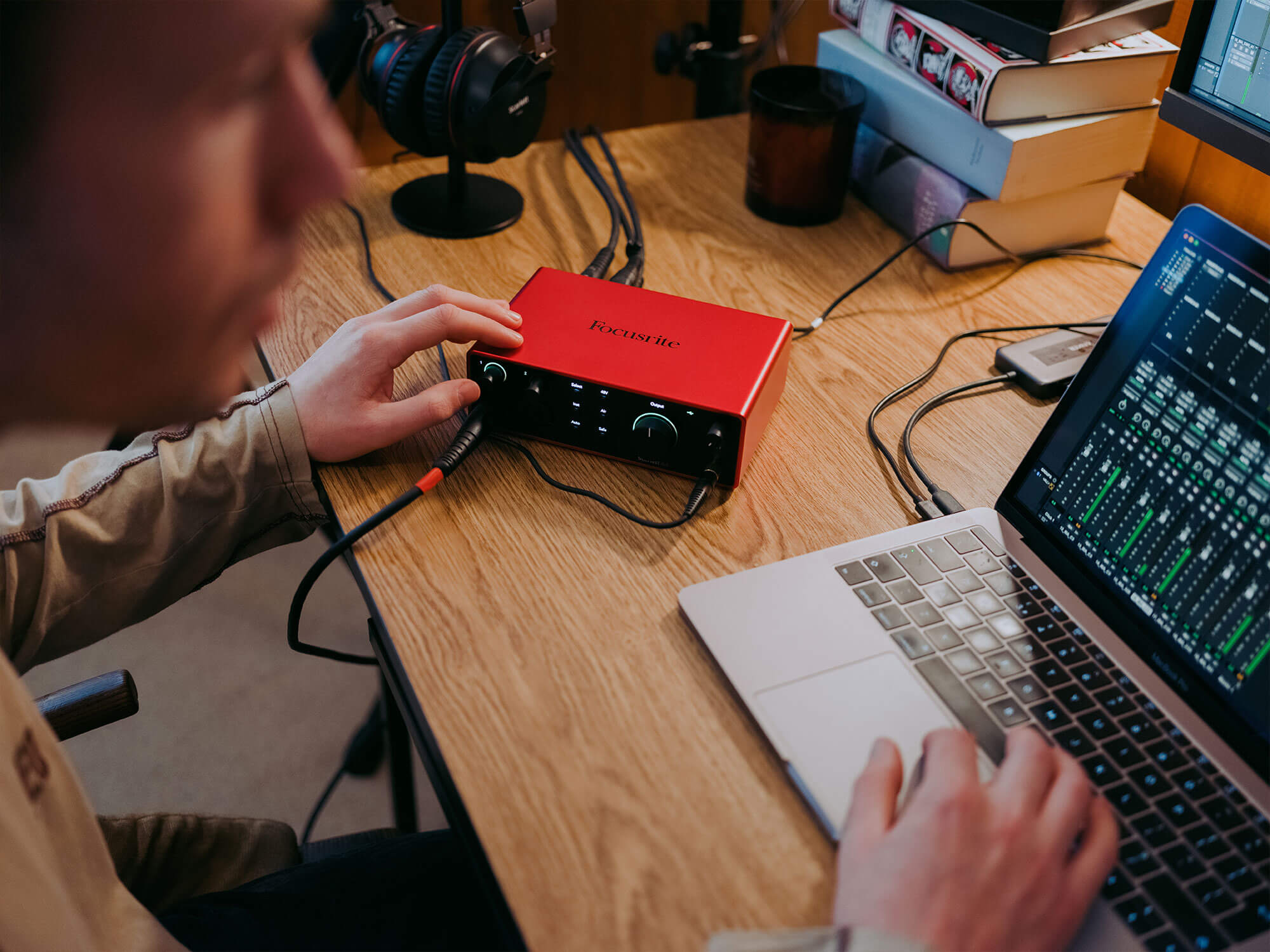
If you’re just looking to play and practise, or even if you’re planning on getting an amp modeller that can double as an audio interface, it may not be necessary to add another item to the shopping list.
If however, you’re after more control on your audio, hoping to record using an amp sim pedal, or you want to record other instruments such as drums, that’s where an audio interface or mixer becomes an integral component of your digital signal chain.
On the simpler, more budget-friendly end of the scale you’ll find the Audient iD4 and Focusrite Scarlett 2i2 4th Gen interfaces; the latter now featuring stereo direct monitoring which is a big deal for those of you wanting to get the most from your stereo amp sims. What you lack in inputs, you gain in ease-of-use and price.
Universal Audio’s Apollo Twin X costs almost £800, but it boasts incredibly low latency for recording – which is invaluable when using amp sims – and comes bundled with some of UA’s stellar hardware plugin emulations, allowing for yet more sonic profiling.
There’s also the PreSonus Quantum HD 2, which can achieve around 3ms latency, comes kitted out with guitar-centric features developed with Fender amongst other pro features and costs 50% less than the Apollo Twin X.
Mixers start at a higher price point due to their increased number of inputs and greater functionality. That being said, Allen & Heath’s ZEDi 10FX, which comes in under £350 and sports some great sounding boutique preamps and the slightly more pricey but fully-featured Tascam Model 12 are well worth investigating if your home recording setup is likely to move beyond guitar alone.
[products ids=”69ARyGFpRDFet9DZNLaqIE,2wL4nkv5Vfp5IkhtS8PZZt,5ggaG7ANt6IHHHzd7QzZAW,3S1JY3asvsRVl5b06L5spq,”]
The post Multi-effects signal chains explained – everything you need to play and record direct appeared first on Guitar.com | All Things Guitar.
Olivia Rodrigo guitar tech on the one thing Gibson keeps getting wrong with its guitar design – as Gibson’s Mat Koehler calls it “disinformation”

Gibson’s been in the guitar making business for well over 100 years, but according to Luis Munoz, guitar tech to pop superstar Olivia Rodrigo, as well as The Smashing Pumpkins and Simple Plan, there’s one thing the brand keeps getting wrong with its guitar design.
In a new video posted on social media, Munoz showcases his process fixing a headstock which had become detached from the neck on a Gibson acoustic guitar, saying the angle of Gibson headstocks in relation to their necks renders them susceptible to breakage.
“Unfortunately, Gibson will never change this,” he writes. “Gibson breaks headstocks so often because of their steep headstock angle, soft mahogany wood, and the thin, weakened area behind the nut (thanks to the truss rod cavity). When they fall, all the force hits that weak spot – so they snap.”
Luis Munoz isn’t the first industry voice to comment on Gibson’s angled headstocks having high potential to snap.
You don’t have to go far to find online forums with guitar players speaking of their experiences with snapped Gibson guitars. So what makes Gibson necks less structurally sound?
As Munoz notes, they feature a steep backward angle compared to the neck, and as Ultimate Guitar notes in this piece from 2023, are carved from a single piece of wood for improved resonance.
This means when space is carved out behind the neck in the space between the headstock and neck, the integrity of the wood grain is compromised. Obviously, a guitar won’t snap on its own, but if a Gibson were to be dropped, for example, on this joint, the force could lead to a break.
But not everyone agrees with Luis Munoz’s assessment of Gibson’s headstock design. Responding in the comment section of his post, Mat Koehler – Gibson’s VP of product – says “there is enough disinformation in this post to fill a magazine…”
Meanwhile, another user notes that while the structure of Gibson headstock joints may be weaker compared to other designs, it’s ultimately careless owners who are the culprits for any breakages.
“So Gibson has been ‘wrong’ for 130 plus years? The key words you use are ‘when they fall’. I’ve owned dozens of Gibsons through the years and had exactly one headstock break, caused by a careless friend not putting my SG back on the guitar stand properly. Accidents happen, but blame careless owners, NOT the guitar.”
While some Reddit users say broken Gibson headstocks are “common”, they also agree that it’s probably the carelessness of owners that ultimately causes such incidents.
“I have 3 Gibsons for 20 years-ish. Never broke any of them,” one user writes. “I believe the key is to not drop them. Hope this helps.”
The post Olivia Rodrigo guitar tech on the one thing Gibson keeps getting wrong with its guitar design – as Gibson’s Mat Koehler calls it “disinformation” appeared first on Guitar.com | All Things Guitar.
Fishman AirLock Wireless GT review – “If you’ve ever wanted a reason to break free from the prison of an old-fashioned cable, this is it”

$319/£429, fishman.com
For decades now, guitar players have chased the dream of truly wireless guitar playing. Especially in a live setting, the ability to be untethered from your amp and pedalboard and roam around the stage (and elsewhere) at your leisure. But there have often been compromises along the way – whether that’s impacting your sound quality, annoying latency issues, bulky and ungainly hardware or simply chewing through 9-volt batteries like an eight-year-old with a pack of gummy bears.
I’ve owned my fair share of wireless systems over the years from a variety of different brands, and I’ve been plagued by all of these problems at one point or another – sometimes all at once! But unquestionably, things have become a lot more compelling in recent years, as advances in wireless audio technology have made the cable-free dream more affordable and, in theory, more consistent and reliable with it.
Into this world comes the AirLock Wireless GT – a brand new compact and pro-focused wireless unit from the kings of acoustic pickup making. Can it be the ultimate stage unit?
 Image: Press
Image: Press
Fishman AirLock Wireless GT – what is it?
There was a time a wireless system involved a transmitter and a fairly bulky receiver that you’d have to find space for on your pedalboard or atop your guitar amp. The AirLock is part of a new generation that slims things down impressively – you have a transmitter that plugs into your guitar (or any instrument with a standard ¼-inch jack input) with a rotating angled jack to suit any socket, and a similarly sized transmitter that you plug in at the other end.
Both units are powered by a rechargeable battery via USB-C, and promise over nine hours of playing time. These batteries are fully replaceable should the capacity degrade over time as all lithium-ion batteries inevitably do, and Fishman sells a replacement pair to ensure you keep using the AirLock Wireless GT for years to come. The batteries are quick-charging too – they can offer up to two hours use after just a quick five-minute charge, which could prove extremely handy for any shows where you’ve forgotten to charge up the night before. You can also hook the receiver up to a standard 9V DC power supply if you’re putting it on your board, meaning that’s one less thing you’ll have to charge.
The key metrics for any wireless unit are range, latency and sound quality, and Fishman promises to have dealt with all three of these. On the range front, it offers an impressive 120 feet of ‘spin range’ – the range it’ll still work even without a line of sight between the transmitter and receiver. This means you won’t have to worry about getting an amp, a person or a drum riser between you and your guitar for it to still work consistently at long distances.
The 2.4gHz wireless band is one that is infamous for being a little temperamental in terms of interference and latency. But Fishman claims to have removed this having the AirLock constantly transmit over two channels at once to avoid dropouts, and will jump to any one of 40 channels in the 2.4gHz band if it detects any interference on the line.
It does this while still offering impressively low 3.3ms latency, and if you’re especially worried about being in a room with a LOT of wireless interference (perhaps you’re the house band at a wireless router conference?) there are three ‘interference’ settings that prioritise signal strength and consistency with the trade off of a little lost latency – even at the highest though it’s still a respectable 4.9ms, and chances are you won’t have to use it.
Tone-sucking (high-end frequency loss from your guitar signal) is another frequent accusation against wireless systems (though some guitarists, like Angus Young, actually like that!). But you probably know that your guitar cable, and especially the length of your cable, is also having an impact on your tone – the cable adds capacitance to your tone depending on how long it is, taking off a bit of the high-end while it does. It’s here that the AirLock does something really clever – the unit has three built-in analog capacitors, replicating the capacitance added by 5, 10 and 15-metre cables. Thus, if you happen to like the way that your favourite long cable colours your tone a bit, you can simply hit the switch on the unit and replicate organically within the unit itself.
The AirLock is portable and rugged, and even comes in its own EVA carrying case, which also stores all the important charging cables. While wireless units are usually preferred for live use, you can even use the AirLock as a direct recording interface – the USB-C port on the receiver does double-duty to enable you to plug straight into your laptop.
 Image: Press
Image: Press
Fishman AirLock Wireless GT – in use
It’s never the easiest job to effectively review a wireless unit – generally the best sign that it’s doing its job properly is that you don’t actively notice it’s there. Even saying that, I was hugely impressed with how easy and seamless the AirLock Wireless GT is to set up, the brightness of the LEDs on board to reassure you that its connection is strong and stable, and how dependable it was even in a busy live environment.
With the appropriate cable length selected on the unit, I’m hugely impressed with how there was little to no real difference between my sound with a cable, and the 118dB of onboard dynamic range mean it handles electric and acoustic guitar just as well as bass tones – compared with other units I’ve tried, the fullness and depth of the tone (especially in the bass) is really impressive.
I didn’t suffer any drop-outs or latency issues while I tested it, and I never had to turn the interference switch above the ‘low’ setting that offered maximum latency. The battery life was around advertised, and keeping it charged up between gigs was a minimal hassle.
 Image: Press
Image: Press
Fishman AirLock Wireless GT – should I buy one?
Fishman has had its proprietary wireless tech for a while – it’s been used in the TriplePlay MIDI controller – so it’s surprising that it’s taken so long for the brand to enter the wireless arena. But boy, am I glad they did.
Some people will always be wary and suspicious of wireless units – I understand where you’re coming from, but since I started using the AirLock I’ve not once had to pull my fall-back cables out of the gig bag.
From the simplicity of setup to the pro-focused cable-length and interference selectors, the AirLock actually makes going wireless fun, not frightening. I certainly didn’t have any of the standard issues that often plague these systems, and it’s comfortably the best wireless unit I’ve ever used. If you’ve ever wanted a reason to break free from the prison of an old-fashioned cable, this is it.
Fishman AirLock Wireless GT – should I buy one?
If your wireless needs are more focused on playing at home, the Positive Grid Spark LINK ($149/£129) is a very affordable and impressively simple bit of kit. Shure’s GLXD16+ ($599/£489) system is a lot more expensive and less user-friendly than the Fishman, but its dual-band system is trusted by some of the biggest pros around. Another home-focused affordable wireless is the Fender Telepath ($209/£155), which utilises the 5.8GHz band to avoid the crowded 2.5gHz band entirely.
The post Fishman AirLock Wireless GT review – “If you’ve ever wanted a reason to break free from the prison of an old-fashioned cable, this is it” appeared first on Guitar.com | All Things Guitar.
The Young People’s Music of Little Folkies | Acoustic Guitar Sessions
Gibson collaborates with Loog for child-friendly range of Les Paul and SG guitars

If your kid daydreams of becoming a rockstar, Gibson’s latest collaboration with Loog might be the perfect addition to playtime. Loog’s funsized three string electric guitars have been given the Les Paul and SG treatment, allowing your child to rock out in style.
Rather than a shoddy shoe-box guitar, Loog’s mini electric models are the real deal. Loog’s take on Gibson’s iconic Les Paul and SG are fitted with real guitar strings and standard tuning, just in a half-scale, three string package.
Loog’s decision to limit the guitars to three strings serves as a way of making real guitar playing less intimidating for younger players. With chords limited to triads, it makes picking up the basics a lot easier – and it renders the transition to a full-scale six string much easier.
The mini Gibson x Loog Les Paul and SG models are also fitted with one pickup, a volume knob, and made of real wood. The Les Paul also comes in a trio of colours, with TV Yellow, Frost Blue and Shell Pink all available. The SG, on the other hand, comes in a single shade of bold Cardinal Red.
 Credit: Gibson x Loog
Credit: Gibson x Loog
Each guitar comes with an array of learning tools to make the process fun and easy. There’s flashcards, a colourful activity book and even an app where you can learn alongside a little Loog monster. The app has video lessons to help fine-tune your guitar skills, as well as guides on how to play 200 songs, from The Beatles to Taylor Swift. There’s also interactive TV show, arcade and bedtime stories to send your kid off to guitar dreamland.
“Getting to collaborate with Gibson has been such an incredible experience and honour for us,” Rafael Atijas, Founder and CEO of Loog Guitars, reflects. “These are the guitars we all drool over – the Les Paul, the SG – and now we’ve had the chance to work with the Gibson team to bring them to life in a way that’s approachable and inspiring for kids. It’s been a pleasure, a joy, and honestly, a real privilege.”
“One of the things I’m most excited about is the Gibson x Loog Activity Book that comes with every guitar,” Atijas continues. “Thanks to it, a 6-year-old will be able to differentiate between Gibson models, learn the story behind the Les Paul, know what a ‘TV Yellow’ finish is, and even recognise a Gibson headstock from a mile away… how cool is that!?”
“We are very proud and excited about our collaboration with Loog, which lets us introduce the next generation to the world of Gibson in a fun, accessible way,” Mat Koehler, Vice President of Product at Gibson, adds. “The Gibson x Loog guitars utilise our iconic colours and shapes with Loog’s intuitive 3-string format to inspire young players to begin their musical journeys.”
All Gibson x Loog models are available now for $229 each.
The post Gibson collaborates with Loog for child-friendly range of Les Paul and SG guitars appeared first on Guitar.com | All Things Guitar.
Life on the Fretboard: Martin Simpson
Martin Simpson is a true icon of the global acoustic music scene. As a guitarist, he has done a huge amount to push the boundaries of the acoustic steel string instrument – showing it can be an expressive and lyrical voice. As a songwriter, he is a masterful storyteller whose poignant lyrics are shared with a disarmingly gentle, no-frills delivery that makes those of us who grew up in the North of England very glad to have done so, and everyone who didn’t wish that they had.
Throughout his career, Martin Simpson has been a vocal proponent of luthier-made guitars – from his early adoption of the work of Northumberland’s Stefan Sobell and Cumbria’s Fylde Guitars to his championing of the next generation of British lutherie with instruments by Taran Guitars in Scotland and Turnstone Guitars in England.
It is no exaggeration to say that Martin Simpson’s musicality and expectations from a guitar have informed the voice of the modern steel-string guitar, perhaps more than any other player. This is very cool indeed.
During my visit to Martin’s home, I had the good fortune to record him playing slide on his Taran guitar. You can watch that video here https://youtu.be/eFJK1zvmPc0, as well as exploring my own instrument by Casimi guitars: https://youtu.be/45WnYusgR4w.
This episode of Life on the Fretboard is brought to you with the kind sponsorship of the author John Stubbings, whose new novel ‘The Guitar Detective’ is a beautiful companion piece to his debut ouvre ‘The Devil Is In It.’ You can get your copy of ‘The Guitar Detective’ right here: https://orpharionpress.com.
You can learn more about Martin Simpson here:
https://martinsimpsonmusic.com
https://www.youtube.com/@MartinSimpsonOfficial
https://www.instagram.com/martinsimpsonmusic
To support Life On The Fretboard please click here https://michaelwattsguitar.com/tip-jars/4745
Michael Watts:
YouTube
https://www.youtube.com/user/michaelwattsguitar
Instagram
https://www.instagram.com/michael.watts.guitar/
Website
https://michaelwattsguitar.com
https://www.fretboardjournal.com
The post Life on the Fretboard: Martin Simpson first appeared on Fretboard Journal.
Source Audio Launches theEncounter Ambient Delay+Reverb
Source Audio, a leader in next-generation guitar and bass effects pedals, proudly introduces the Encounter Ambient Delay+Reverb, a fully loaded, dual-engine effects pedal designed to unlock immersive, atmospheric soundscapes. Building upon the legacy of Source Audio’s award-winning Collider Delay+Reverb, the Encounter features dual signal processing, allowing users to combine any two of the pedal’s six delay and six reverb effects. Where the Collider focused on classic delay and reverb effects, Encounter ventures into uncharted tonal territory, delivering new, otherworldly effects for guitar, bass, synth, and adventurous sound designers of all kinds.
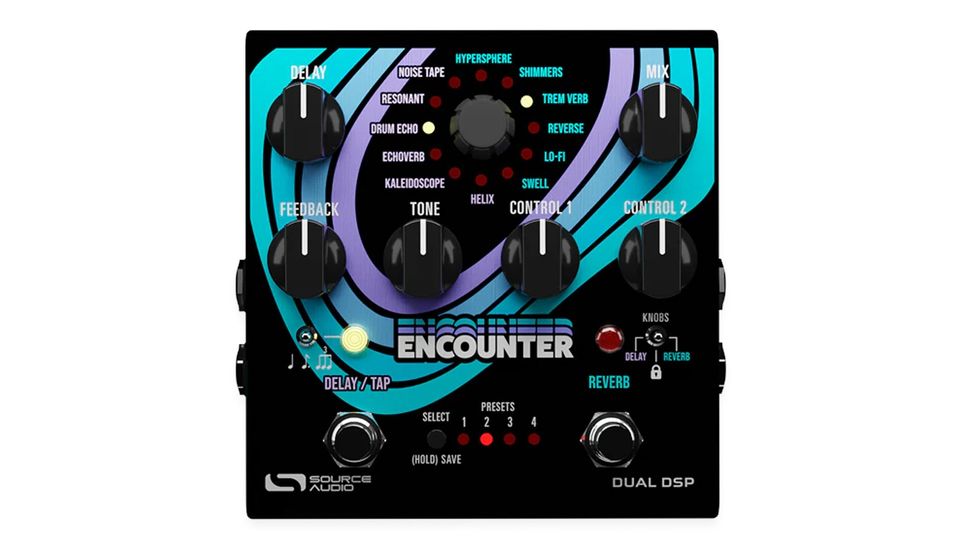
“You asked, so we delivered!” says Roger Smith, President of Source Audio. “Ever since the release of the Collider Delay+Reverb, players have asked us to push further — into more adventurous, exploratory delay and reverb textures. Encounter answers that call. It opens up an expansive new universe of sonic possibility, combining reimagined classics with brand-new algorithms that explore both the familiar and the beautifully unknown.”
At the heart of the Encounter are six delay and six reverb engines that can be used individually or combined in pairs — this includes dual delay and dual reverb setups. Users can route dual effect combinations in series, parallel, or split stereo, with independent footswitch control for each engine, effectively offering the power of two pedals in one easy-to-navigate enclosure. Stereo ins and outs, full MIDI implementation, 8 onboard preset slots (128 presets with MIDI), external expression control, and seamless integration with Source Audio’s free Neuro 3 editing software for iOS, Android, macOS, and Windows further elevate the pedal’s flexibility and creative potential.
The Encounter’s effects collection features brand-new engines such as Hypersphere, a gravity-defying ambient reverb inspired by infinite spatial reflections, Kaleidoscope, a cascading, harp-like delay effect, and Shimmers, a rich, dual-pitched shimmer reverb designed for lush harmonic layering.
Modernized favorites from Source Audio’s acclaimed Ventris Dual Reverb and Nemesis Delay ADT also make a return — Reverse, Lo-Fi, Trem Verb, and Swell reverbs, along with Helix, Drum Echo, Noise Tape (based on the Roland Space Echo) and Resonant delays — all reimagined with expanded parameter control.
In addition, musicians can preview and explore the sounds and editing capabilities of the Encounter before purchasing the pedal, using the Neuro 3’s new SoundCheck™ feature. Neuro 3 is Source Audio's entirely free effects editing, preset sharing, and organizing software. SoundCheck features prerecorded, unaffected guitar, bass, keyboard, and drum loops that can be played through bit-perfect replications of Source Audio One Series pedals. Users can audition presets or use the effect editor and hear changes in real-time, using only a smartphone or computer.
Brickhouse Toneworks Introduces Mason Deluxe P.A.F. Humbuckers
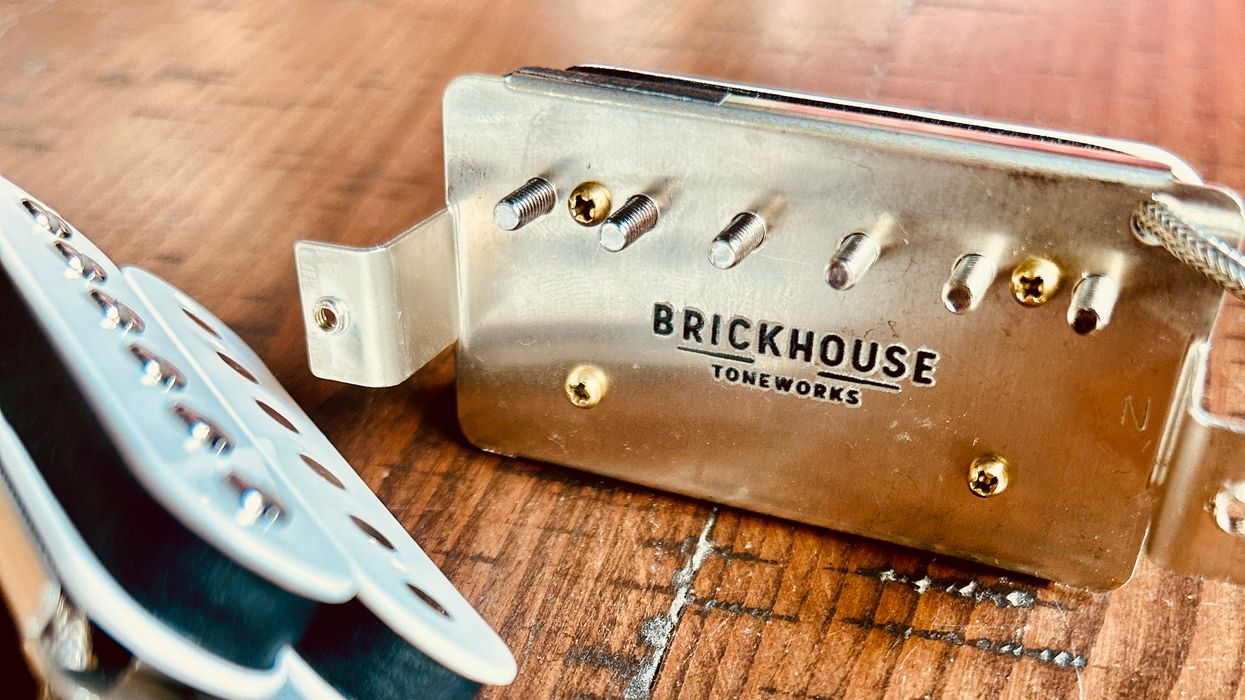
Adding to the company’s lineup of premium US-made pickups, Brickhouse Toneworks has introduced the Mason Deluxe P.A.F. pickup. Available individually or in matched sets, the Mason Deluxe delivers the classic, exquisitely balanced tone of a vintage 1960s P.A.F. humbucker with added bite. They are a direct drop-in replacement for standard sized humbuckers.
Sporting AlNiCo 4 magnets for enhanced attack and articulation, the Mason Deluxe P.A.F. has the clarity of a lower wind with the power of a fuller wind. Pickup master David Shepherd designed the pickup with two slightly different wire thicknesses on each coil, along with carefully calibrated asymmetrical coils, to bring out the maximum frequencies and dynamic range possible.
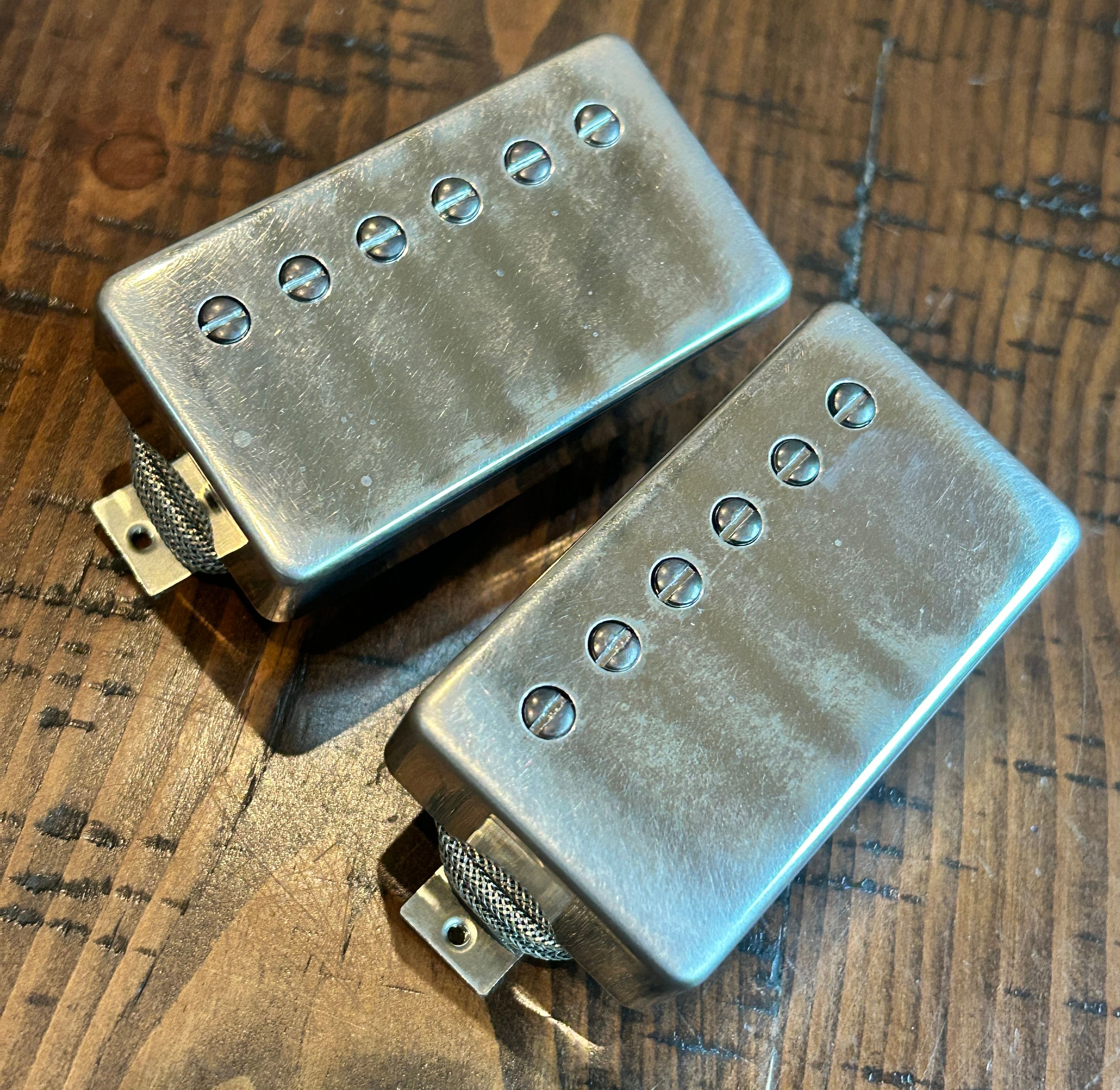
Expanding on the legacy of Brickhouse Toneworks’ highly regarded 1960 P.A.F. and Semi 60 P.A.F. humbuckers, the Mason Deluxe P.A.F.'s deliver a unique tonal profile characterized by a chimey, bell-like clarity and exceptional articulation. The sound is both smooth and responsive, with a dynamic range that allows for a sweet, rolled-off tone as well as a powerful, aggressive distortion. A defining feature is the rich, harmonic overtones that bloom and sustain, providing a heightened sense of depth and dimensionality. The pickups also exhibit a slight microphonic effect, which enhances pick attack definition. This results in a complex, yet clear sound—fat and woody in the neck position, and sparkling with pronounced punch and tonal definition in the bridge.
The result: an extraordinarily responsive P.A.F. humbucker with a transparent and open sound, allowing the guitar and player's natural tone to be the star of the show.
Key Features of the Mason Deluxe:
- AlNiCo 4 Roughcast Long Bar Magnets, Unpotted Coils
- Vintage Correct Long Leg Frames and Butyrate Plastic Bobbins
- Vintage Correct Alloys, Coil Wire and Braided Single Conductor Leads
- Vintage Correct Hand Ground, Hand Buffed P.A.F. Covers
- DC Resistance - Bridge: 8.1k (Average)
- DC Resistance - Neck: 7k (Average)
- Made in the USA with premium quality materials
The Brickhouse Toneworks Mason Deluxe P.A.F. street price starts at $195 each and starts at $390 per set. Visit www.brickhousetone.com or contact info@brickhousetone.com for more information and order yours directly.
$1,299 Tube Amp That Does It ALL?! | Bad Cat Ocelot Amp Demo
Mad Cat!—The 2 X EL84, 20-watt Ocelot can breathe fire when it’s not sounding silky smooth. The Ocelot brings together the warmth of pure analog tube circuitry with advanced digital features, redefining what’s possible in a small-format amp. Whether you're recording at home, gigging, or practicing silently with headphones, the Ocelot adapts to your environment without ever compromising your tone.
Channel 1 features sparkling, high-headroom cleans with the ability to nudge into rich edge-of-breakup tones via a Hi/Lo mode switch. Channel 2 brings tight, punchy crunch and full-bodied, high-gain saturation—with articulate response and massive sustain.
Each channel has its own volume control, and the amp includes shared Treble, Mid, Bass, and Presence EQ for easy tone shaping.
Two Notes Torpedo DynIR integration with six onboard virtual cabinet presets from the official Bad Cat DynIR Pack. Selectable Power Modes – Choose between 20W for full punch or 1W for quiet playing. XLR and Headphone Outs – For silent practice or direct-to-DAW recording, complete with Cab Sim and adjustable Cab Level control. Buffered Effects Loop – Keep your pedals sounding pristine and punchy. USB-C Port – For firmware updates and remote editing via Two notes Torpedo Remote software. MIDI Control – Full MIDI implementation for switching channels, modes, and cab presets on the fly. And thanks to its internal speaker load, you can use the Ocelot without an external cabinet—perfect for late-night jams or tracking in a silent setup.
Fender is making Road Worn guitars again – this time with the Vintera II line

Fender has expanded its Vintera II range – which pairs vintage ‘50s, ‘60s and ‘70s specs with forward-thinking appointments for the modern player – with a limited-edition line of Road Worn models.
Fender’s Road Worn guitars, of course, come pre-aged – or “relic’d” – to give brand-new guitars the look of an instrument with years of use.
They have however, become rarer in the Fender catalogue in recent years, but the introduction of these new Road Worn Vintera II models signals that the Big F might have further plans to dive back into artificial aging.
Your mind when you think Road Worn might go to noticeably battered instruments which signal years of heavy ‘road’ use. But the new Vintera II Road Worn range introduces a new – and far more subtle – aging process which aims for a less in-your-face ‘closet classic’ vibe.
It’s a similar aesthetic to the Heirloom finish introduced on Bruno Mars’ 2023 signature Stratocaster, and on the American Ultra Luxe Vintage collection – which landed just last month – with minimal obvious dings and scratches and an emphasis on soft patterns of wear and semi-gloss finishes.
Naturally, the Vintera II Road Worn range is headed up by its artificial aging process, but it also features a series of specs designed for vintage guitar lovers, including ‘50s and ‘60s era-correct pickups for “vintage-accurate tone”, and authentic neck shapes for a period-correct feel.
The range comprises four models – a Stratocaster, Telecaster, Jazzmaster and Precision Bass – with colours including Sonic Blue, Black, 3-Color Sunburst, Fiesta Red, Blonde, Charcoal Frost Metallic and Burgundy Mist Metallic.
“Featuring a variety of vintage colours finished in Road Worn aged nitrocellulose lacquer, the Vintera II Road Worn ‘60s Stratocaster recreates the look and feel of a well-played classic,” says Fender.
“The limited Road Worn models are enhanced with a new subtle aging process combining light checking, gentle wear patterns and a semi-gloss finish, while maintaining the authentic broken-in feel players love about vintage Fenders.”
Price-wise, the Limited-Edition Vintera II Road Worn Stratocaster and Telecaster are priced at £1,349, the Jazzmaster and Precision Bass at £1,399.
For more info, head to Fender.
The post Fender is making Road Worn guitars again – this time with the Vintera II line appeared first on Guitar.com | All Things Guitar.
EBS updates NeoLine 112 Cabinet with deeper dimensions and improved sound
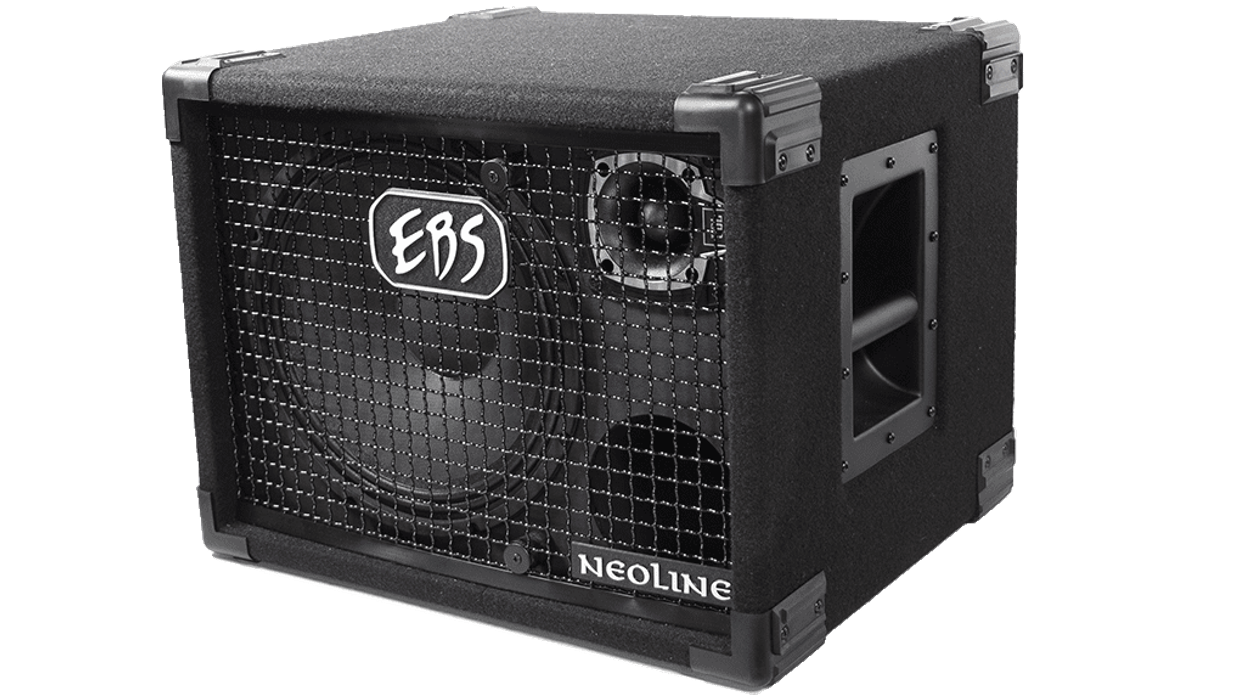
EBS is proud to unveil the newly enhanced NeoLine 112 Mk2 bass cabinet, now shipping with key upgrades that bring even more power, low-end, and reliability to the stage.
The first significant change: the cabinet is now 4 inches deeper, offering a noticeable improvement in low-end response, projection, and overall tonal richness. This enhancement ensures that today's bassists get the punch and presence they need from a compact cabinet, whether they're in the studio, on tour, or pushing the limits live.
Second, EBS has swapped out the previous flip handles in favor of a single heavy-duty deep-dish handle. This small but significant upgrade helps eliminate the risk of rattling noise, making the cab perform securely even at high volumes, while also improving durability and ease of transport.
Third, the high-performance tweeter is now isolated and sealed from the rest of the cabinet, which also helps to reduce the risk of noise due to the sound pressure within the cabinet.Despite the deeper cabinet, and due to the Neodymium speakers and choice of wood, it remains a lightweight cabinet, weighing in at 14.35 kg (31.6 lb).
Already a favorite for its lightweight construction and road-ready build, the updated NeoLine 112 (Mk2) now delivers even greater performance with no compromises. It's a compact speaker for serious players. Despite the improvements, the price remains intact.
The updated NeoLine 112 Mk2 is available now.
Find out more at https://ebssweden.com/cabs/neoline/
Fender Introduces LE Vintera II Road Worn
Today, Fender is expanding its acclaimed Vintera® II series with a Limited Edition Road Worn® lineup, era-correct classics from the ‘50s and ‘60s pair vintage-inspired designs and modern upgrades with the lived-in look of a well-loved instrument. Each model features a new subtle aging process—light checking, gentle wear patterns, and a semi-gloss finish—delivering unmistakable vintage feel and unmatched sound of a classic Fender®.
Limited Edition Vintera® II Road Worn® ‘60s Stratocaster®
($1,599.99 USD, £1,349 GBP, €1,599 EUR, $2,649 AUD, ¥269,500 JPY)
Featuring a variety of vintage colors finished in Road Worn® aged nitrocellulose lacquer, the Vintera® II Road Worn® ‘60s Stratocaster® recreates the look and feel of a well-played classic. The limited Road Worn models are enhanced with a new subtle aging process combining light checking, gentle wear patterns and a semi-gloss finish, while maintaining the authentic broken-in feel players love about vintage Fenders. The ‘60s “C”-shape maple neck with 7.25” radius rosewood fingerboard and vintage-tall frets provides supreme comfort and outstanding feel. Under the hood, you’ll find a trio of vintage-style ‘60s pickups that deliver all the warm, sparkling tones that made Fender® famous. Other features include a synchronized tremolo with bent steel saddles for expressive vibrato and vintage-style tuning machines for enhanced tuning stability. Options include Rosewood Fingerboard in Sonic Blue and Maple Fingerboard in Black.

Fender Vintera II Road Worn '60s Stratocaster Maple Fingerboard Electric Guitar
Limited Edition Vintera® II Road Worn® ‘60s Telecaster®
($1,599.99 USD, £1,349 GBP, €1,599 EUR, $2,649 AUD, ¥269,500 JPY)
Featuring a variety of vintage colors finished in Road Worn® aged nitrocellulose lacquer, the Vintera® II Road Worn® ‘60s Telecaster® recreates the look and feel of a well-played classic. The limited Road Worn models are enhanced with a new subtle aging process combining light checking, gentle wear patterns and a semi-gloss finish, while maintaining the authentic broken-in feel players love about vintage Fenders. The ‘60s “C”-shape maple neck with 7.25” radius rosewood fingerboard and vintage-tall frets provides supreme comfort and outstanding feel. Under the hood, you’ll find a pair of vintage-style ‘60s pickups that deliver all the crystal-clear chime and raw, steely twang that made Fender® famous. Other features include a vintage-style 3-saddle bridge with slotted steel saddles and vintage-style tuning machines for enhanced tuning stability. Options include Rosewood Fingerboard in Burgundy Mist Metallic and Maple Fingerboard in Blonde.

Fender Vintera II Road Worn '60s Telecaster Rosewood Fingerboard Electric Guitar
Limited Edition Vintera® II Road Worn® ‘50s Jazzmaster®
($1,699.99 USD, £1,399 GBP, €1,649 EUR, $2,799 AUD, ¥275,000 JPY)
Featuring a variety of vintage colors finished in Road Worn® aged nitrocellulose lacquer, the Vintera® II Road Worn® ‘50s Jazzmaster® recreates the look and feel of a well-played classic. The limited Road Worn models are enhanced with a new subtle aging process combining light checking, gentle wear patterns and a semi-gloss finish, while maintaining the authentic broken-in feel players love about vintage Fenders. The ‘50s “C”-shape maple neck with 7.25” radius rosewood fingerboard and vintage-tall frets provides supreme comfort and outstanding feel. Under the hood, you’ll find a pair of vintage-style ‘50s single-coil pickups that deliver all the sweet and sparkling, warm and woody tone that made Fender® famous. Other features include a vintage-style floating tremolo for expressive vibrato and vintage-style tuning machines for enhanced tuning stability. Options include Rosewood Fingerboard in 3-Color Sunburst and Rosewood Fingerboard in Fiesta Red.

Limited Edition Vintera® II Road Worn® ‘60s Precision Bass®
($1,599.99 USD, £1,399 GBP, €1,649 EUR, $2,649 AUD, ¥269,500 JPY)
Featuring a variety of vintage colors finished in Road Worn® aged nitrocellulose lacquer, the Vintera® II Road Worn® ‘60s Precision Bass® recreates the look and feel of a well-played classic. The limited Road Worn models are enhanced with a new subtle aging process combining light checking, gentle wear patterns and a semi-gloss finish, while maintaining the authentic broken-in feel players love about vintage Fenders. The ‘60s “C”-shape maple neck with 7.25” radius rosewood fingerboard and vintage-tall frets provides supreme comfort and outstanding feel. Under the hood, you’ll find a vintage-style ‘60s split-coil Precision pickup that delivers all the warm, dynamic and powerful tone that made Fender® famous. The vintage-style 4-saddle bridge and vintage-style tuning machines provide classic looks with enhanced intonation and tuning stability to complete the package. Options include Rosewood Fingerboard in Fiesta Red and Charcoal Frost Metallic.

Gibson partners with Marc Jacobs on super-limited Les Pauls

Collaborations between fashion brands and guitar makers aren’t a totally novel concept – Fender has partnered with such brands as streetwear label Supreme and high-end fashion house Yves Saint Laurent, for example.
But it’s slightly rarer for Gibson to partake in similar left-field collabs. That said, the guitar maker has just partnered with Marc Jacobs to create a series of Les Pauls complete with custom artwork, straps and even pick tins.
Unveiled at Marc Jacobs’ popup store at New York Fashion Week – during which Gibson Spotlight artist Devon Thompson performed a solo set with one of the guitars – the collection comprises four new Gibson Les Pauls, three with artwork by renowned artist Hattie Stewart, and a Standard model with Marc Jacobs’ Daisy Joy design.
“Music and fashion have long been inseparable as forms of self-expression, so this collaboration in the name of joy felt incredibly fitting and necessary,” says Gibson’s Katie Knipper.
“Our Gibson team worked tirelessly with the Marc Jacobs and Nordstrom teams to make ‘Joy’ happen, and having Devon bring things to life in real time was a cherry on top.”
Gibson hasn’t been quite as prolific as Fender in collaborating with fashion brands, but after Fender’s collabs with the likes of Supreme, Yves Saint Laurent and even Bvlgari, which resulted in an ultra-limited run of Stratocasters in 2024, perhaps Gibson has been inspired.
The four super-limited Les Paul guitars are available to buy at Nordstrom NYC and select Marc Jacobs stores.
Learn more at Gibson.
The post Gibson partners with Marc Jacobs on super-limited Les Pauls appeared first on Guitar.com | All Things Guitar.
Billianne on viral success, battling imposter syndrome and her years-in-the-making debut album

“Everything started with singing,” begins Canadian musician Billianne. From the age of four, she would go around her family home singing random songs that she had heard on TV shows or when listening to the car radio with her mum. “Everything was my stage,” she says. Her parents even turned their front porch into one. “I was always pretending,” she recalls, having joined school funk bands, played trombone and regularly performed recitals during her childhood. “I can’t remember not singing.”
A family trip to Nova Scotia during which her brother put on Mumford & Sons’ first album is another fond music memory. “I liked the way that it brought us all together, memorising the words on a 19-hour drive and head-banging in the van,” she recalls of listening to 2009’s Sigh No More in full. Beyond the family bonding, a young Billianne was enamoured by Marcus and co’s lyrics: “I love their storytelling, they are such great songwriters and it’s really great folk music”.
While the foundations were set, it wasn’t until her late teens that she first picked up a guitar. “My dad always had a Norman in the house,” she reflects of the “Canadian staple”. He also had a Simon and Patrick, which Billianne used for most of her learning. Around the age of 17, she started trying to learn the instrument properly by covering songs. “I was always on Guitar Tabs and trying to figure out the songs,” she remembers, specifically citing doing a lot of two chord movements.
 Image: Press
Image: Press
Best Is Yet To Come
Taking guitar as a subject during her last year of high school enabled her to “learn a little bit more”. She found it easy to pick up – at least at first. “With a lot of instruments, I always find it really exciting and fun at the beginning,” she says, having learned the G chord, D chord, A minor and F. “But getting past that point… I still feel that every time I try to learn something new on the guitar, it does feel hard to me.”
She persevered and, in 2021, began uploading cover videos to social media. “A lot of times I was singing to karaoke tracks from YouTube,” she recalls. But it was her rendition of Noah Reid’s 2018 song Simply the Best that proved the turning point. “That video was my first time finger picking,” Billianne recalls. “Half of the things with the guitar and me, I’m just like ‘well, I’ll give it a shot’.”
It worked: the cover caught the attention of Taylor Swift, Joe Jonas, P!nk, Oprah and Michael Bublé. “It’s wild,” she recalls. “I can’t believe those people may have found my name and looked me up and listened to my music.” The most surreal moment was the Joe co-sign: “he posted an Instagram story at a campfire with the track paired, which must mean he was listening to it, so that feels intimate to me”. Equally thrilling was the comment from Taylor – especially as she and her brother were Swifties and bonded over her albums Fearless and Red.
Aside from impressing big names, TikTok proved educational for Billianne. “I always look out for what guitars people are playing,” she says. Watching friends online also helped her discover alternate tunings. “I didn’t realise it was a thing. Obviously, there’s these three pegs that do something, but I didn’t realise people lowered the tune of their guitar and had these open tunings that create such inspiration. I felt like ‘wait, your guitar sounds so different from mine, what is going on?’”
As Billianne’s popularity on social media grew, she began playing shows. “There’s nothing like it, but when I first started performing with guitar, I was very nervous on stage,” she says. “It’s not my main thing, but I love how it pairs with my voice,” she adds. “And, once I do get it, it feels really special to be able to accompany myself in that way.”
While her nerves have decreased, she thinks those initial feelings came from still being in the process of learning the instrument. “I think it was a bit of imposter syndrome,” she considers. “I was thinking ‘I’m not a guitar player and there are probably guitar players in the crowd’.” Another worry was whether or not she was “playing the part well – the guitar part and the guitar player part”.
Remembering what she had learned in high school – about the importance of practicing – helped to gradually minimise these concerns. “That is what will make you feel more comfortable on stage,” she says. “I had to tell myself that, and I still believe that about guitar, especially with how much I know about it now. I think so many of my mistakes come from a lack of confidence rather than knowledge about what I’m doing. I need to be confident about where my fingers are going and what’s happening, but that comes with practice.”
 Image: Press
Image: Press
Show And Tell
Billianne’s biggest test came with her TV debut – on NBC’s Today, in April 2024. “That was really fun, and I was playing guitar live, which I was so nervous about.” With her band’s encouragement, her performance of folk-pop song Daydream went off without a hitch. “It was really cool to be live on TV while my parents are back in Canada; I think they must have thought ‘she’s the same little girl but she’s on TV’.”
In February this year, she made her second screen appearance, this time singing her song Enough on the TV show of a music “idol” she once messaged: Kelly Clarkson. “I don’t DM celebrities a lot, but I DM’d her way back in the day,” Billianne laughs, adding that she was a big fan of American Idol when she was a mentor on the talent show. “I said ‘I want to sing with you one day’, so hopefully that comes true,” she says. “It was great to have her hold the cover art of my song and introduce me.”
As well as building a name for herself across the US, Billianne scored a hometown hit with her song Crush, which made the Top 10 at Canadian Top 40 Radio. “These things are crazy to think about, like that was a real thing that happened,” she laughs of the success last summer. “It was being played everywhere. We would be in the car and hear it. My friends would send videos while they were in the dollar store.”
Billianne has since toured with Julia Jacklin, KT Tunstall and “Canadian legend” Serena Ryder – during a double-bill, the latter two met her on the night. “It’s so kind when big names care like that.” Serena has been keeping tabs on her growth since: “she DM’d me and said ‘you’re doing amazing, I’m just checking up on your page and everything looks so great’.”
Transportation Station
Now, Billianne is gearing up to release her debut album, Modes of Transportation, which has been in the works for three years.
“To have this big project that had so much thought and care and people working on it, that makes me feel more like an artist,” she says. As she rode her bike, took the train and learned to drive on the highway during that time, its layered title has multiple meanings. “It’s a metaphor of being in your twenties and figuring out how you get from who you are to who you want to be in the next 10 years.”
This journeying sense of discovery is channeled through the tracklist and pacing of the record, which was recorded across Ontario – from a downtown Toronto house to a quiet cabin in Huntsville and a family basement studio in Etobicoke. “We wanted to try out different sounds,” she says, adding that there are “there are so many guitars on this record”.
Having used them throughout the writing process and to channel different emotions, she doesn’t remember exactly how many, but says her collaborators Duncan [Hood] and Nick [Ferraro] are “a little bit geeky with this stuff”. They would choose a Nylon instead of a steel string “to suit the vibe of the song,” she says, adding that the lyrics usually come first. “I tend to have song starts and ideas. Sometimes it’s a full verse, or the chorus melody, or a line and then I take it to Nick and Duncan and we work it out.”
For the song Future Emma, she remembers them discussing the tone of the electric guitar because it starts the track and “needed to be exactly what I wanted”. Meanwhile, the track ‘Let Me Run’ sees the three of them each play a different guitar: “I start that track and then they come in on guitar, so that was special”. It’s also the only one where she plays guitar on track, which is something Billianne is keen to do more of. “Recording a guitar is a totally different thing,” she says; “it’s so humbling”.
As an artist who is always working on the next thing – “there’s lots more to come,” she teases – her message to aspiring guitar players is simple. “You’ve just got to pick it up and try something,” she encourages. “Sometimes it looks so scary sitting in your room. It’s like ‘Oh my God, there’s this thing with six strings and you can do so many things on it… but the options are endless’.”
Modes of Transportation out August 15. Billianne tours the UK in November.
The post Billianne on viral success, battling imposter syndrome and her years-in-the-making debut album appeared first on Guitar.com | All Things Guitar.




